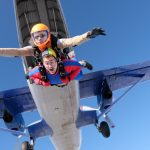If your idea of skydiving Miami is a reel of sun-washed coastline and a roaring freefall, you’re only seeing the loudest five percent of the experience. The other ninety-five percent is planning, weather, altitude choices, body position basics, and knowing what actually happens from the moment you suit up to the moment your feet touch grass again. This guide pulls together the questions people ask most—fear, motion sickness, weight limits, “what do I do with my hands?”, coastal wind patterns, and how high you should go—so your first tandem feels exciting without surprises.
What Tandem Skydiving Really Is (and Isn’t)
A tandem jump means you’re harnessed to a licensed instructor who flies the parachute, handles navigation, and manages every safety checklist. Your job is simpler: hold the student body position in freefall, listen for a few cues, and enjoy the ride. Most first-timers are surprised by the relative quiet after opening, the long canopy glide, and how much time there is to look around and breathe.
The Phases, Start to Finish
- Briefing & fit: Paperwork, a quick safety talk, and a snug harness fitting.
- Climb: 15–25 minutes in the plane, depending on altitude. This is when nerves peak; the door isn’t open yet.
- Exit & freefall: 30–60 seconds of wind-on-face intensity. It feels more like floating on a strong air stream than “falling.”
- Canopy: 4–7 minutes of quiet flight, gentle turns, and coastline views if you’re near the water.
- Landing: A slide-in or stand-up landing on grass. You’ll lift your legs on cue; your instructor handles the rest.
How High Should You Jump? (Altitude Isn’t Just a Flex)
Altitude affects freefall time, how much scenery you see before opening, and how quickly coastal haze becomes an issue. Here’s a simple way to think about it:
| Exit Altitude | Typical Freefall | What You Notice Most | Good For |
| ~10,000 ft | ~30–35 sec | A fast highlight reel; shorter climb | Budget-minded first jumpers or time-tight schedules |
| ~12,000 ft | ~45 sec | Enough time to get past “door shock” and actually look around | Balanced first-timer experience |
| ~14,000 ft | ~55–60 sec | Long, steady freefall; more time to try a gentle turn with guidance | People who want the “full” skydive feel |
| >15,000 ft (oxygen required) | ~65+ sec | Specialty experience; not always available | Repeat jumpers chasing seconds |
Rule of thumb: If you want a calmer headspace mid-air, the extra 10–15 seconds at higher exits helps; you settle in and remember to look at the horizon.
Wind, Weather, and Coastal Reality
Coastal areas can serve up smooth morning air and gustier afternoons. Sea breezes often build through the day, clouds can stack over warm land, and summer brings quick, short-lived showers. None of that is “bad”—it just means the safest operations will shuffle call times or hold jumps until conditions stabilize. Expect flexibility. If you’re prone to motion sickness, earlier flights and smaller canopy turns usually feel better.
Requirements You’ll Hear (and Why They Exist)
- Age: Adult consent is standard; under-18 jumpers are typically not permitted.
- Weight & fit: There’s a practical upper limit for safe harnessing and equipment performance; instructors need to control both freefall and landing.
- Health: Controlled blood pressure, no recent major surgery, and the ability to lift your legs for landing are common considerations. If in doubt, a quick doctor’s note helps everyone.
Fear, Nerves, and the “Door Moment”
Most first-timers report the scariest part isn’t falling—it’s the anticipation. A few tips that work:
- Look out, not down. The horizon gives your eyes a fixed reference and helps your brain calm down.
- Breathe on the count. Inhale as the instructor taps; exhale during the exit.
- Mindset shift: Your instructor has thousands of pattern repetitions. Treat the jump like a guided tour where you participate.
Body Position: The Easy Version
You’ll practice a simple student arch (hips forward, knees slightly back, chin up) and keep hands near the harness until the instructor signals you to spread them. Think “comfortable beach stretch,” not “stiff superhero.” Under canopy, sit into the leg straps and listen for “legs up” on final approach.
First-Timer Checklist (Numbered)
- Sleep and eat like normal. A light meal helps—don’t fly on an empty stomach or a triple espresso.
- Wear layers you can peel. Coastal mornings can be cool, afternoons warm; snug athletic wear beats loose, flappy clothes.
- Tie hair and remove dangly jewelry. Anything that whips in the wind will feel worse at 120 mph.
- Closed-toe shoes only. No sandals or boots with hooks.
- Empty pockets. Phones and keys don’t fly; they become projectiles.
- Be honest on the waiver. Instructors adjust the plan to you—motion sensitivity, prior injuries, all of it.
- Ask for mellow canopy turns. If you’re unsure about spins, say so; gentle flight is still gorgeous.
- Confirm the landing cue. “Legs up” is the magic phrase—practice it seated before boarding.
- Hydrate, but not frantic chugging. Bathroom breaks are easier on the ground.
- Plan buffer time. Weather holds and aircraft cycles happen; treat the day as an experience, not a quick errand.
Camera Questions Without the Sales Pitch
Helmet-mounted footage shows your expressions in freefall; outside-air videographers capture the exit and wide scenery. Motion sickness prone? Skip aggressive canopy spirals even if you’re filming. If you bring your own small action camera, expect strict policies—attachment points and instructor approval exist for good reasons.
Common Forum Debates, Answered Simply
- Eat or not before jumping? Yes, normally—think “light breakfast,” not “empty or overloaded.”
- Will my ears hurt? Gentle equalization (yawn/swallow) during descent usually solves it. Mention any chronic ear issues during your briefing.
- Glasses or contacts? Both work under snug goggles; bring a protective case either way.
- Can I jump with a head cold? Avoid it—congestion makes pressure changes miserable.
Choosing a Configuration: Single vs. Repeat Intent
Your first tandem is about learning the rhythm safely. If you think you’ll do a second jump, consider starting at a mid-or higher altitude for more freefall practice. On repeat visits, you can request milder or sportier canopy flight, try a sunset load, or focus on specific skills (stable exit, horizon awareness, a gentle heading change on signal).
What “Good” Feels Like in the Air
- Stable exit: It feels like a strong wind catching you—not a rollercoaster drop.
- Breathable freefall: You can inhale; the trick is to open your mouth slightly and look forward.
- Canopy calm: The world goes quiet. You’ll hear wind and the instructor’s voice. Most people smile here and actually remember the view.
Post-Jump: The Hour After Landing
You might feel a head-rush of adrenaline, mild jelly-legs, or surprising hunger. Hydrate, have a snack, and skim your video before you forget the door count and the first horizon glimpse. If you’re motion-sensitive, choose a shady spot and sit for a minute—the world will stop “moving” quickly.
Quick Reference Table: Planning Your Tandem
| Topic | Good Rule of Thumb | Why It Helps |
| Altitude choice | 12–14k ft for first-timers | More time to settle in and look around |
| Best time of day | Early to mid-morning | Smoother air, steadier winds |
| Food & drink | Light meal + water | Keeps nerves from feeling like nausea |
| Clothing | Snug layers + closed-toe shoes | Comfort and clean body position |
| Motion sensitivity | Ask for mellow canopy turns | Reduces dizziness post-landing |
| Camera plan | Confirm attachments & roles | Safety and better framing |
| Weather mindset | Build buffer time | Coastal breezes and pop-up clouds happen |
| Landing cue | “Legs up” on final | Protects ankles/knees, smooth touchdown |
Final Thought
A tandem skydive isn’t one giant leap; it’s a sequence of small, well-rehearsed steps. When you understand how altitude shapes freefall, why morning air feels friendlier, how a simple student arch makes everything easier, and why “legs up” is the most important phrase you’ll hear, the experience becomes less about surviving the door and more about actually seeing the world from a new angle. Whether your mental picture of skydiving miami is turquoise water or simply conquering a personal fear, the real win is walking away with a memory that’s vivid for the right reasons—and the confidence to say, “I’d do that again.”










